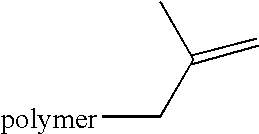Polyalkene amines with improved applicational properties
a polyalkene amine and application technology, applied in the field of polyalkene amines with improved applicational properties, can solve the problems of severely contaminated carburetors and intake systems of gasoline engines, and also the injection system of fuel metering, so as to improve the low temperature performance of a polyalkene amine, improve the intake system-cleaning action of gasoline fuel, and improve the effect of additive functionality
- Summary
- Abstract
- Description
- Claims
- Application Information
AI Technical Summary
Benefits of technology
Problems solved by technology
Method used
Image
Examples
example 1
Preparative Example 1
Preparation of a Polyisobutene Amine Formulation Having Improved Cloud Point
[0138]Polyisobutene amine (PIBA) prepared according to EP-A-0 244 616 is admixed with MIHAGOL M in the PIBA / solvent mixing ratio specified there in Example 1 (62.5:37.5 parts by weight).
[0139]In the same manner, an inventive formulation was prepared, except that a mixture of 66.7 parts of PIBA and 33.3 parts of MIHAGOL M was used.
[0140]Cloud point and pour point were measured for both formulations. The results are summarized in the following Table A:
[0141]
TABLE APrior artInventionCloud point−27.6° C.−29.4° C.Pour point −27° C. −27° C.
[0142]Surprisingly, a significant improvement in cloud point could be achieved in accordance with the invention.
example 2
Preparative Example 2
Preparation of a Polyisobutene Amine Formulation Having Improved Low Temperature Properties
[0143]500 g of polyisobutene having a molecular weight Mn of 1000, 269.2 g of a solvent composed of (80% by weight of MIHAGOL M and 20% by weight of LIAV 230) and 2.8 g of cobalt octacarbonyl are heated at 185° C. for 5 h in a 2.5 l autoclave having a lift stirrer with stirring under 280 bar of 1:1 CO / H2. Subsequently, the mixture is cooled to room temperature, the catalyst is removed with 400 ml of 10% aqueous acetic acid and the mixture washed to neutrality. The resulting oxo product is treated with 1 l of ammonia, 300 g of ethanol and 100 g of Raney cobalt in a 5 l roller autoclave under a hydrogen pressure of 200 bar at 180° C. for 5 h. After the mixture has been cooled, the catalyst is filtered off, excess ammonia is evaporated off and the solvent is distilled off.
[0144]The polyisobutene used is a highly reactive polyisobutene according to DE-A-2,702,604 having a frac...
example 3
Preparative Example 3
Preparation of a Polyisobutene Amine Formulation Having Improved Low Temperature Properties
[0148]Preparative Example 1 was repeated, except that the solvent used was MIHAGOL M and / or LIAV 230 in various mixing ratios. The polyisobutene amine polymer to solvent mixing ratio in the end reaction product is 66:34. Pour point and storage stability of the resulting product were determined for the different batches. The results are compiled in the following Table C:
[0149]
TABLE CMihagol:LIAV ratio1)100:080:2070:3050:500:100Pour point−27° C.−33° C.−36° C.−39° C.−51° C.Storage stabilityMany crystallineFew crystallineClear, fluidClear, fluidClear, fluidat −35° C.precipitatesprecipitates1)Weight ratio
[0150]The results show that suitable variation of the solvent enables further surprisingly significant improvements in the storage stability.
PUM
| Property | Measurement | Unit |
|---|---|---|
| cloud point | aaaaa | aaaaa |
| pour point | aaaaa | aaaaa |
| temperature | aaaaa | aaaaa |
Abstract
Description
Claims
Application Information
 Login to View More
Login to View More - R&D
- Intellectual Property
- Life Sciences
- Materials
- Tech Scout
- Unparalleled Data Quality
- Higher Quality Content
- 60% Fewer Hallucinations
Browse by: Latest US Patents, China's latest patents, Technical Efficacy Thesaurus, Application Domain, Technology Topic, Popular Technical Reports.
© 2025 PatSnap. All rights reserved.Legal|Privacy policy|Modern Slavery Act Transparency Statement|Sitemap|About US| Contact US: help@patsnap.com

